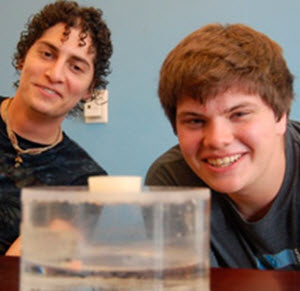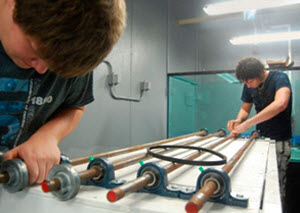
Oscar and Cameron in front of a cylindrical tank that will be used to house samples. Photo Credit: ADDOMEx
Cameron Jackson, a sophomore, is studying marine biology Texas A&M University at Galveston (TAMUG) and Oscar Agueda is a senior who will be getting his degree in marine science (TAMUG); both students are minoring in chemistry. When asked about career aspirations they stated that they hoped to go on to graduate school. “I want to do deep-sea research; bioluminescence in particular is something that really interests me” says Cameron. Oscar, on the other hand, is more interested in ocean and environmental sciences “So I’m right where I need to be”.
Both students approached Dr. Peter Santschi and Dr. Kathy Schwehr of LOER lab (Laboratory for Oceanographic and Environmental Research) in hopes of gaining valuable research experience. Drs. Santschi and Schwehr are principal investigators for Aggregation and Degradation of Dispersants and Oil by Microbial Exopolymers (ADDOMEx) , one of several consortia that are funded by the Gulf of Mexico Research Initiative to research the impacts of oil spills on the marine environment.
The students have been working to build a roller table that will be used for a set of experiments conducted by ADDOMEx. Advice and specifications for the roller tables have been provided by Dr. Uta Passow, a fellow researcher from the University of California Santa Barbara.
The roller table will be used keep samples of phytoplankton and microbes in constant motion to study the formation of marine snow with and without the addition of oil and Corexit (a common dispersant used to treat oil spills).
“It’s like a shaker table, but for a cylindrical tank”, says Oscar.
“I think my dad put it best,” Cameron explains which a chuckle, “in that the roller table is essentially a glorified hot dog cooker at a convenience store. And this is really the perfect way to think about it because it continually rolls the tanks in a horizontal manner.”
“The roller tables will be used to mimic the movement of water in the ocean” says Cameron. “Stagnant water really doesn’t exist in the ocean, and using standing water in our experiments would create conditions that don’t accurately reflect what is happening in the ocean.”
“It’s been a challenge to invent ways to overcome little problems like ensuring that the screws, bolts, and mounts were the proper size” he goes on. “For the first three or four days I didn’t have a drill, so I put the frame together using a screwdriver. I actually broke the screwdriver.”
When asked how this project has changed their perspectives on how research is done, Cameron stated that he “always imagined that you just buy any instruments you might need, so being told to actually design and build the roller tables was a bit of a surprise.”
“I expected that we would be in the lab most of the time” said Oscar. “Instead we’ve been outside working on the table almost every day, but it’s been fun. I would definitely recommend working in a lab to other students, it looks great on your resume… just be prepared to get sweaty!”
According to Cameron you should “bring a pair of headphones”.
After finishing the roller tables, the students will be moving on to work that will include measuring the tensile strength and hydrophobicity/hydrophilicity of the exopolymeric substances that are produced by the study species of marine phytoplankton and microbes in upcoming experiments.
Follow ADDOMEx on Facebook (www.facebook.com/addomex/), Twitter www.twitter.com/addomex/, and Instagram www.instagram.com/addomex/.
Credit for this story: ADDOMEx

